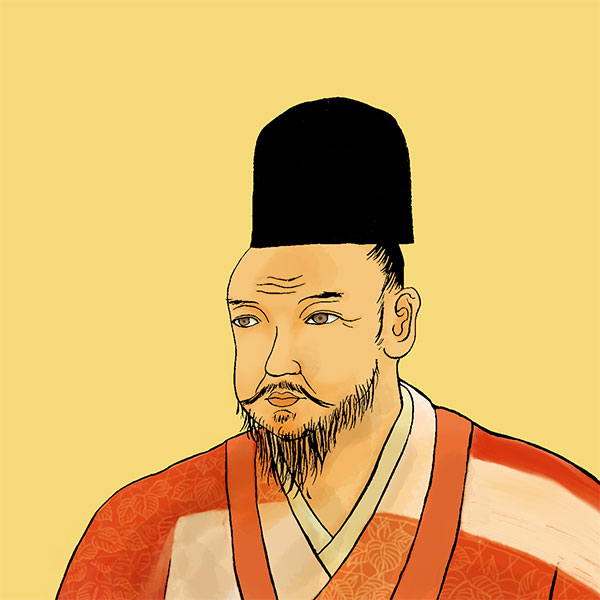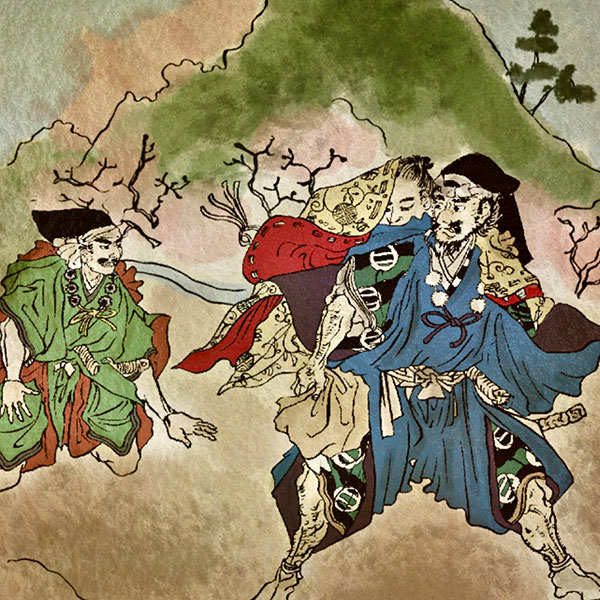Yoshiteru Ashikaga (2/2)The 13th shogun of the Muromachi shogunate, known as the master swordsman.

Yoshiteru Ashikaga
- Article category
- biography
- name
- Yoshiteru Ashikaga (1536-1565)
- place of birth
- Kyoto
- Related castles

Nijo Castle
- related incident
On October 2nd, Nagayoshi, in response to Harumoto Hosokawa's raising an army with the Kozai clan and others at Hozenji, sent Yoshiteru, through Sadataka, an imperial letter ordering Enryakuji Temple on Mt. Hiei and Yoshikata Rokkaku to drive out Harumoto. Request issuance.
On the 15th of the same month, Miyoshi Miyoshi defeated the Kii Negoro clan who had rushed in to reinforce Takamasa, and the Hatakeyama clan was definitively defeated. Iimoriyama Castle in Kawachi was opened on the 24th of the same month, and Takaya Castle was opened on the 27th, and Takamasa retreated to Sakai.
In May 1561, Harumoto, who had been the leader of the anti-Miyoshi movement for a long time, agreed to make peace with Nagayoshi and entered the priesthood and entered Fumonji Temple in Tomita, Settsu.
In July, Takamasa Hatakeyama and Yoshikata Rokkaku formed an uprising in the Kinai region and fought against each other in Kumeda for seven months. The uprising of the Hatakeyama clan and the Rokkaku clan was intended to contain the growing Miyoshi clan in the Kinai region, and on the 23rd of the same month, Yoshiteru sent Takamasa and Yoshitaka to the front against Naomitsu Yukawa in Kii, so he commanded Nagayoshi and Yoshioki and his son. We are keeping Takamasa in check by issuing a letter of intent to be on our side.
After Sadataka's death, Yoshiteru appointed his close vassal Harukado Settsu as the new steward of Mandokoro, and did not appoint anyone from the Ise clan. This brought an end to the control of government by the Ise clan, which was impossible even for the third shogun Yoshimitsu Ashikaga to intervene in, and opened the way for the shogunate shogun to take control of government. He also solidified his position as shogun by taking control of the enormous rights and interests that had been monopolized by the Ise clan.
Conflict with Mr. Miyoshi
After Yoshiteru returned to Kyoto, he made political decisions independently without becoming a puppet of the Miyoshi clan such as Nagayoshi Miyoshi, and solidified his political position.However, on the other hand, the appearance of feudal lords who showed loyalty to the shogun , which was a threat to Mr. Miyoshi and made him more wary.
In June 1564, Nagayoshi killed his second younger brother, Fuyuyasu Ataka, on suspicion of treason, but after his death, he was overcome with intense regret and his own illness worsened.
On July 4 of the same year, Nagayoshi, the successor of the Miyoshi clan, died of illness. After Nagayoshi's death, Nagayoshi's nephew and son of Kazutoshi Miyoshi (later changed his name to Yoshitsugu) became the new lord of the Miyoshi clan, and he was assisted by the Miyoshi Sanninshu, Hisashi Matsunaga, and his eldest son Michi Matsunaga. I did.
However, with the death of Nagayoshi and other key members of the Miyoshi clan, the Miyoshi clan's authority declined decisively and it began to decline. On the other hand, Yoshiteru's authority increased with this opportunity, and he attempted to carry out further political activities in order to restore the power of the shogunate.
From December of the same year, Yoshiteru began construction of a new mansion on the site of the residence of the Shiba clan, the Sankanrei, and the remains of the Buei camp. This mansion is called Nijo Gosho because it existed in Nijo, Kyoto.
Yoshiteru's final moment "Eiroku Incident"
However, Yoshiteru, who insists on direct rule as a shogun, is a hindrance to the Miyoshi clan, which is trying to install a puppet shogun.
The Miyoshi Sanninshu and others teamed up with Yoshitsugu Ashikaga of Awa and tried to persuade the Imperial Court to make Yoshitsune's eldest son, Yoshihide (Yoshiteru's cousin) the new shogun, but the court did not listen.
On the other hand, the Rokkaku clan of Omi, which Yoshiteru relied on, had been unable to leave their territory since the Kannon-ji riot in August 1997.
On April 30th, 1565, Shigezo Miyoshi came to Kyoto and had an audience with Yoshiteru on May 1st. At that time, Yoshiteru gave Shigemasa the epithet of ``Yoshi'' and the official rank of Sakyo no Taifu, and Shigemasa took the name Yoshishige.
After that, the situation in Kyoto will remain calm until May 18th.
On May 19th, Yoshishige, along with the Miyoshi Sanninshu and Hisamichi, led an army of approximately 10,000 people who had gathered under the pretext of visiting Kiyomizu-dera Temple, and suddenly stormed the Nijo Imperial Palace, appealing to the shogun for a lawsuit (demand) and requesting intercession. Invading the Imperial Palace in search of the Emperor (Eiroku Incident). The attack was aimed at the Nijo Imperial Palace, which was nearing completion, and the battle is said to have started around 8 a.m.
After Miyoshi's army invaded the Nijo Imperial Palace, Yoshiteru realized that he was outnumbered and prepared for death. After giving sake to his retainers and holding a final banquet, everyone shared a farewell drink, after which Shinshi Seisha, who was the intermediary with the Miyoshi clan, apologized for allowing the enemy to invade. I committed suicide in front of him.
After that, Yoshiteru and his retainers faced off against Miyoshi's army, and all of his retainers were killed in the battle. Around 11 p.m., Yoshiteru finally ran out of strength and was killed by Miyoshi's soldiers. He passed away at the age of 30.
There are various theories regarding Yoshiteru's final moments, but in Frois's "History of Japan", Yoshiteru himself wielded a naginata, then drew his sword and resisted, but when he was wounded by an enemy's spear and was lying on the ground, they attacked him all at once. It is said that he was hanged and killed.
In "Ashikaga Kiseiki," Yoshiteru fights hard and keeps Miyoshi's soldiers at bay, and in the end, when he is knocked down by a spear, his soldiers cover him with shoji screens from all sides, and stab him from above. It is written that he was killed, but in the "Kototsugu Kyoki" written by Yotsugu Yamashina, who was in Tokyo at the time of the incident, it is written that Yoshiteru suffered "life damage," and it is also said that he died in battle or that he committed suicide. It can also be taken as
At this time, along with Yoshiteru, many of the shogun's retainers died in battle or committed suicide, but Miyoshi's army also forced Yoshiteru's biological mother, Keijuin, to commit suicide, and also killed his concubine, Kojujutsu. After the slaughter was over, Miyoshi's army set fire to the Nijo Imperial Palace, and it is said that many palaces were engulfed in flames.
The Eiroku Incident made the world angry. The feudal lords who were close to Yoshiteru were particularly angry, and Terutora Uesugi is said to have vowed to the gods and Buddha to ``decapitate Miyoshi and Matsunaga.''
In addition, Munefusa Yasumi, a senior vassal of the Hatakeyama clan in Kawachi, expressed his anger, saying, ``This is unprecedented and absolutely unacceptable. (omitted) It's a matter of regret,'' and he proposed to senior vassals of the Uesugi clan to mourn and fight. It is said that Yoshikage Asakura's senior vassals expressed their anger as well, saying, ``This is truly an arbitrary act, unprecedented, and we must do nothing about it.'' This incident had such a huge impact on the world.
Reread Yoshiteru Ashikaga's article
- related incident

- WriterTomoyo Hazuki(Writer)I have loved history and geography since my student days, and have enjoyed visiting historical sites, temples and shrines, and researching ancient documents. He is especially strong in medieval Japanese history and European history in world history, and has read a wide range of things, including primary sources and historical entertainment novels. There are so many favorite military commanders and castles that I can't name them, but I especially like Hisashi Matsunaga and Mitsuhide Akechi, and when it comes to castles, I like Hikone Castle and Fushimi Castle. Once you start talking about the lives of warlords and the history of castles, there's a side of you that can't stop talking about them.




